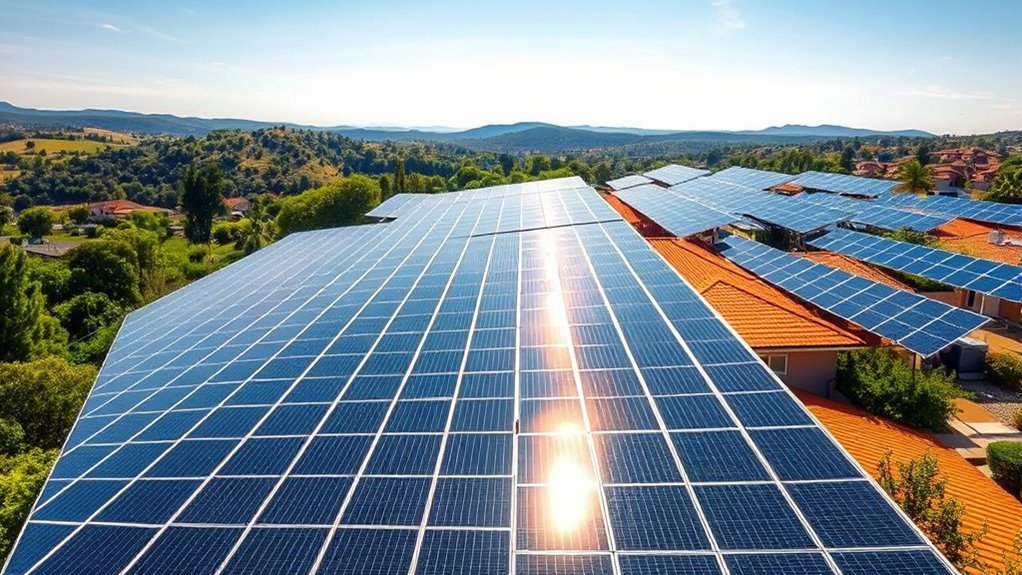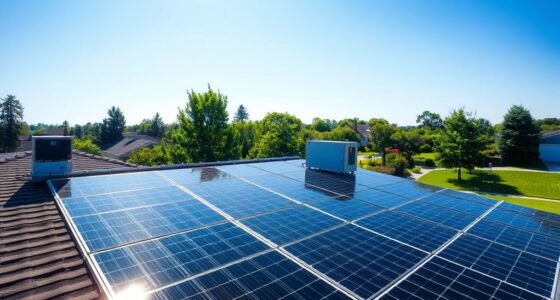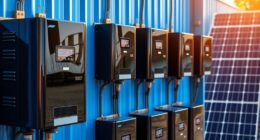Installing solar panels starts with evaluating your energy needs and site conditions. You’ll want to choose the right panel type—monocrystalline for efficiency or polycrystalline for budget-friendliness. The installation typically spans one to three days, involving mounting and wiring. Maintenance is key: regularly clean panels and check for issues. Plus, monitoring tools help track performance over time. If you’re keen to make the most of your solar system, there’s plenty more to explore!
Key Takeaways
- Assess your energy needs and consider efficiency improvements before selecting solar panel types and installation methods.
- Choose between monocrystalline, polycrystalline, or thin-film panels based on space and budget considerations.
- Ensure proper electrical wiring and compliance with NEC standards for safe and efficient system operation.
- Schedule regular maintenance and visual inspections to enhance performance and prevent issues with your solar system.
- Utilize real-time monitoring tools to track energy production and detect inefficiencies promptly.
Planning and Preparation for Solar Panel Installation
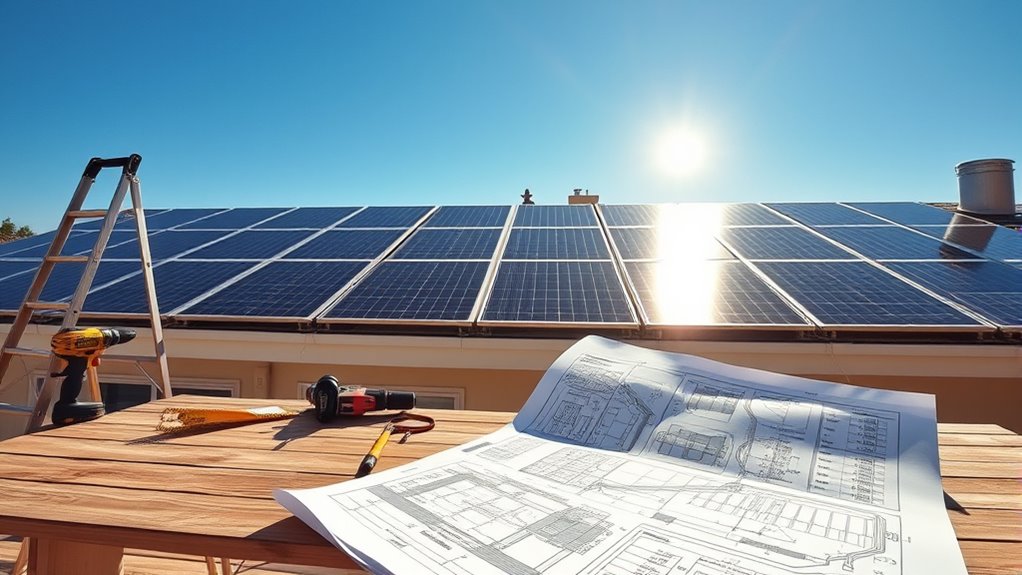
When you’re planning for solar panel installation, it’s crucial to assess your energy needs first.
Start by reviewing your past electricity bills to find your average monthly energy usage. This data helps you determine the solar system size you’ll require.
Before installation, identify areas where you can improve energy efficiency, which can reduce overall consumption. Additionally, integrating hydrogen fuel cells into your energy strategy may further enhance sustainability and energy independence. Understanding the economic benefits of solar energy can also motivate your decision to install solar panels. Implementing energy-efficient practices, such as using heat pumps, can complement your solar system by lowering your overall energy demand.
You should also perform a load calculation to verify your home’s electrical system is compatible with solar power. Additionally, it’s important to conduct a site assessment to identify optimal panel placement.
Finally, consider setting up an energy monitoring system to track your solar energy production and usage.
With these steps, you’ll have a solid foundation for a successful solar panel installation.
Choosing the Right Solar Panel Type
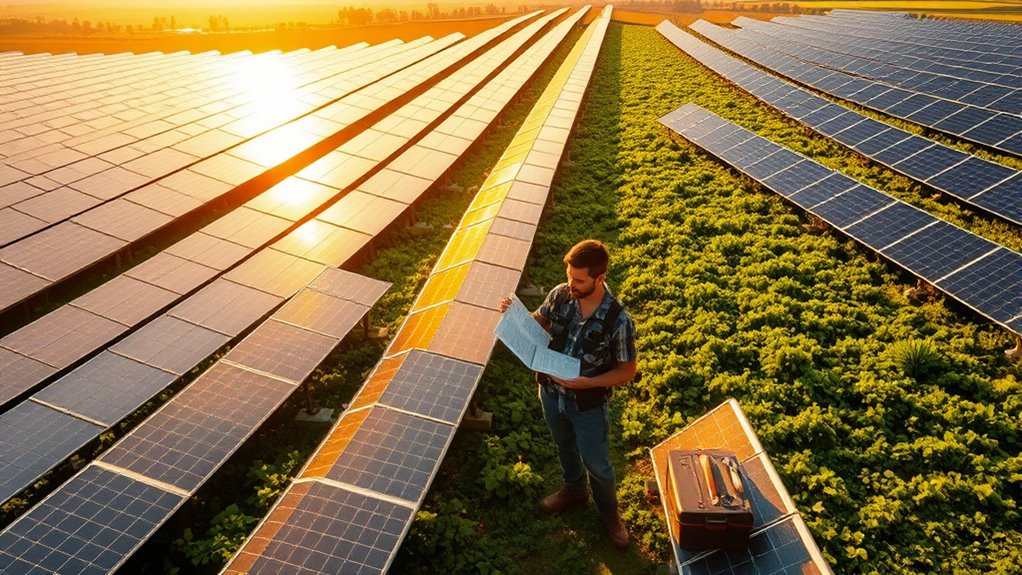
Choosing the right solar panel type can greatly impact your energy production and long-term savings.
Selecting the appropriate solar panel type is crucial for maximizing energy output and ensuring lasting savings.
You’ll typically choose among three main types: monocrystalline, polycrystalline, and thin-film. Monocrystalline panels are the most efficient, offering 15%-22% efficiency, making them ideal for limited space, but they come at a higher cost. Monocrystalline panels are highly efficient but more expensive, with efficiency ratings ranging from 17% to 22% and power outputs typically between 320 watts to 375 watts or higher. Additionally, angled panels can maximize sunlight exposure, optimizing energy production. These panels are recognized for their high efficiency and durability, ensuring a reliable energy source for years to come. The nutritional content of foods like Akara can be seen as a parallel to the efficiency of solar panels, where both provide substantial benefits in their respective domains.
Polycrystalline panels are a budget-friendly option with 13%-18% efficiency, suitable for larger installations.
Finally, thin-film panels are the most cost-effective but have the lowest efficiency at 10%-12%.
Consider your space and budget when selecting a panel type. High-efficiency options can yield better long-term savings, while cost-effective choices may require more installation space.
Balancing these factors will help you make the best decision for your energy needs.
The Installation Process Explained
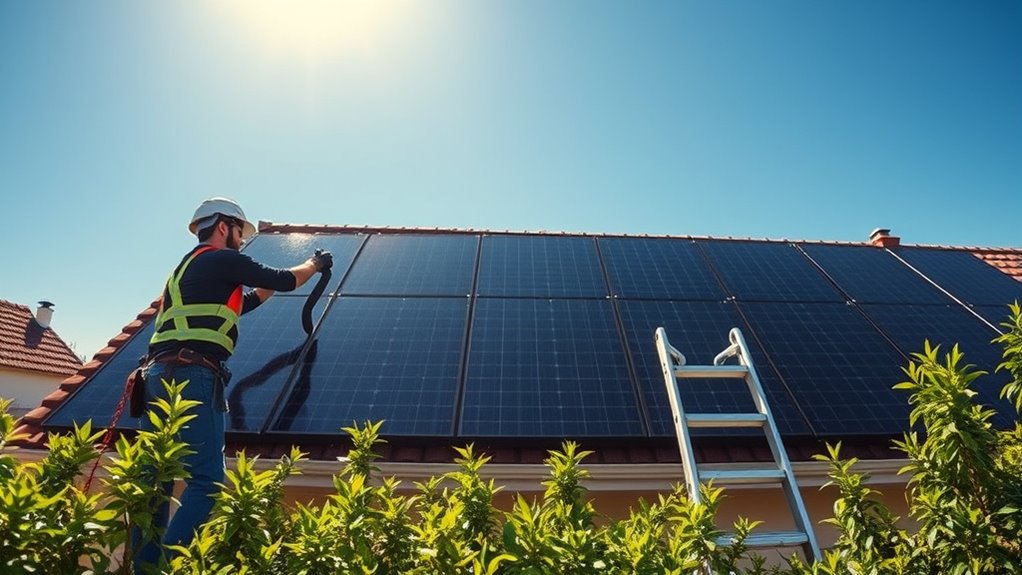
Once you’ve selected the right type of solar panels for your needs, the next step is to navigate the installation process.
Start with a thorough site assessment to find the best location, considering your roof’s orientation and any shading issues. After that, finalize your system design based on your energy requirements. Understanding budgeting for the installation costs is essential to ensure you can manage the financial aspects effectively. Additionally, it’s wise to consider estate planning to ensure your solar investment aligns with your long-term financial goals. During this phase, consider the importance of open communication about any concerns or questions you have regarding the installation process.
You’ll need to sign a contract with a solar installation company and obtain necessary permits, including building and interconnection permits. It’s important to understand that permitting approval times can vary by location and system complexity, so plan accordingly.
Once permits are secured, the physical installation usually takes one to three days. Your team will install the mounting systems, inverters, and guarantee everything’s grounded safely.
Finally, expect inspections from local authorities before your solar system is activated and connected to the grid.
Electrical and Wiring Considerations
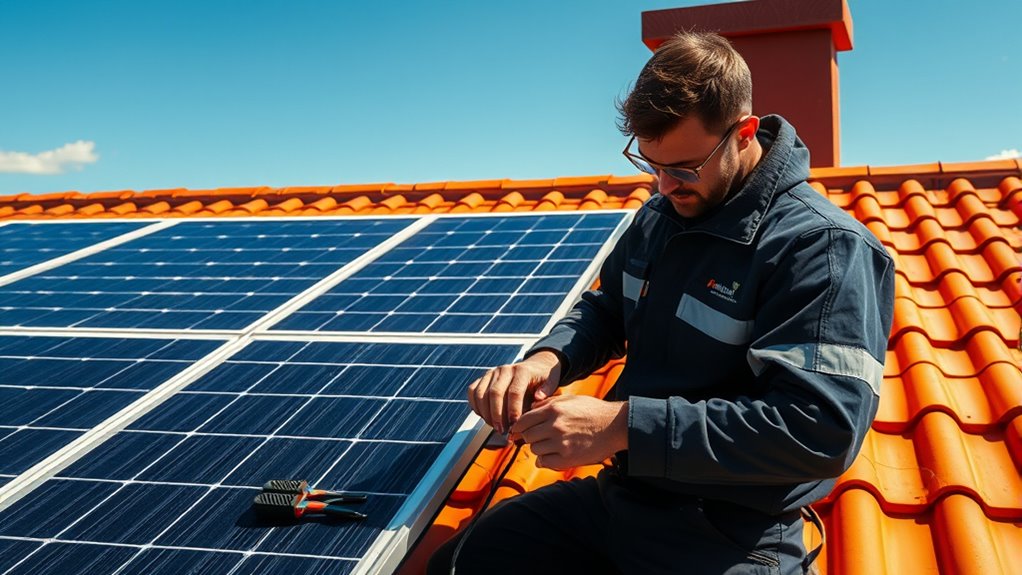
Understanding electrical and wiring considerations is vital for a successful solar panel installation. You’ll need to choose the right components, like solar panels, charge controllers, and inverters, to guarantee efficient energy conversion and storage. Wiring configurations, such as series or parallel, affect voltage and current flow, so pick one that suits your system’s needs. Don’t forget about electrical safety; installing disconnects, breakers, and grounding equipment is essential to prevent overloads and shocks. It’s important to remember that a solar panel’s primary function is to convert sunlight into direct current (DC) electricity, laying the foundation for the entire system. Additionally, integrating renewable energy technologies can enhance the overall effectiveness and sustainability of your solar setup. The use of heat pumps in conjunction with solar panels can further optimize energy efficiency and reduce overall energy costs. Moreover, ensuring that your system is compliant with IRS regulations can help safeguard your investment in renewable energy. Make certain everything meets NEC compliance for safety standards. Use high-quality solar cables and MC4 connectors to minimize energy loss and secure a reliable connection. Proper wire management will enhance your system’s efficiency and longevity, setting you up for a successful solar experience.
Maintenance and Monitoring of Solar Systems

Regular maintenance is essential for your solar system’s performance and longevity. Debris like dust and leaves can block sunlight, reducing energy output. You should schedule cleanings based on your environment—frequent in arid areas and regular inspections for corrosion in coastal regions. Comprehensive solar maintenance plans can help ensure that all critical aspects of your solar system are regularly addressed. Additionally, understanding the greatest happiness principle can guide your approach to optimizing energy use for both personal and environmental benefits. Furthermore, implementing best lifestyle practices can enhance your overall efficiency and satisfaction with the solar system. Being aware of state tax implications related to energy investments can also inform your financial planning for a solar installation.
Annual professional checks can catch issues early, while visual inspections help identify anomalies. Real-time monitoring tools track energy production, allowing you to analyze performance trends and detect inefficiencies. Timely repairs prevent small problems from escalating, and keeping spare parts handy minimizes downtime. By staying proactive with maintenance, you guarantee your system runs efficiently and complies with warranty requirements.
Frequently Asked Questions
What Are the Environmental Impacts of Solar Panel Production?
When you consider the environmental impacts of solar panel production, you’ll notice several factors at play.
The manufacturing process consumes significant energy, often from fossil fuels, contributing to a carbon footprint. Additionally, it releases harmful emissions and uses large amounts of water.
While the materials involved can be recycled, the extraction and production phases pose risks to ecosystems.
However, advancements are being made to improve energy efficiency and reduce emissions during production.
How Long Do Solar Panels Typically Last?
Solar panels typically last between 25 to 40 years, depending on their quality and environmental conditions.
You’ll find that high-quality monocrystalline panels usually outlast polycrystalline ones.
Even after their warranty period, they continue to produce electricity, though at reduced efficiency.
Factors like climate, installation quality, and maintenance practices play a considerable role in how long your panels will effectively generate power.
Regular upkeep can help extend their lifespan considerably.
Can Solar Panels Work During Cloudy or Rainy Weather?
Imagine a sunflower turning its face toward the sky, even on cloudy days.
Yes, solar panels can work during cloudy or rainy weather! While they might produce 10-25% less energy, they still generate electricity from diffuse light.
Rain also cleans your panels, boosting efficiency over time.
Just like nature adapts, your solar system can thrive in various conditions, proving that even on dreary days, there’s potential for energy.
What Happens to Solar Panels at the End of Their Life?
At the end of their life, solar panels typically last 25-30 years before you’ll need to contemplate replacement.
You have a few options: recycle them, reuse them, or dispose of them in a landfill.
While recycling can recover valuable materials like aluminum and copper, it’s often complex and costly.
If you choose disposal, be cautious—improper methods can lead to environmental hazards due to toxic materials like lead and cadmium.
Are Solar Panels Safe During Severe Weather Events?
Yes, solar panels are generally safe during severe weather events.
Their robust design and strong mounting systems help them withstand high winds and heavy rain.
While they may not generate power during the worst parts of a storm, they often resume operation quickly once the weather clears.
If you guarantee proper installation and maintenance, your solar panels can provide reliable energy even when traditional power sources fail, enhancing your home’s resilience.
Conclusion
Installing solar panels can feel overwhelming, but the freedom of generating your own energy makes it all worth it. Picture the sun shining brightly above, powering your home while you take control of rising energy costs. With a little planning and care, you’ll shift from uncertainty to empowerment—watching your investment flourish while contributing to a greener planet. Embrace the journey; each step you take not only benefits you but also paves the way for a sustainable future.
